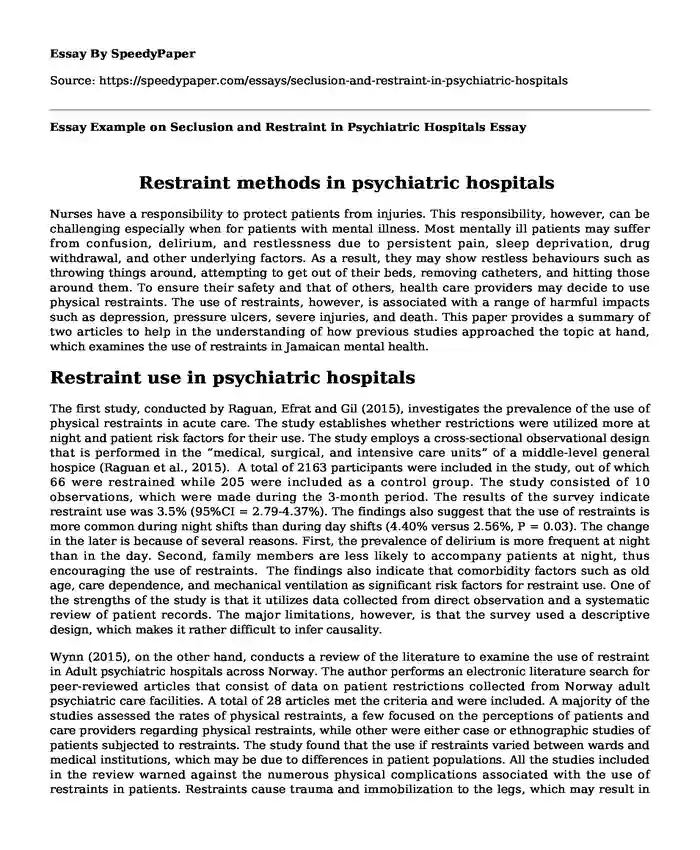
| Type of paper: | Essay |
| Categories: | Health and Social Care Nursing Medicine Mental health |
| Pages: | 3 |
| Wordcount: | 672 words |
Restraint methods in psychiatric hospitals
Nurses have a responsibility to protect patients from injuries. This responsibility, however, can be challenging especially when for patients with mental illness. Most mentally ill patients may suffer from confusion, delirium, and restlessness due to persistent pain, sleep deprivation, drug withdrawal, and other underlying factors. As a result, they may show restless behaviours such as throwing things around, attempting to get out of their beds, removing catheters, and hitting those around them. To ensure their safety and that of others, health care providers may decide to use physical restraints. The use of restraints, however, is associated with a range of harmful impacts such as depression, pressure ulcers, severe injuries, and death. This paper provides a summary of two articles to help in the understanding of how previous studies approached the topic at hand, which examines the use of restraints in Jamaican mental health.
Restraint use in psychiatric hospitals
The first study, conducted by Raguan, Efrat and Gil (2015), investigates the prevalence of the use of physical restraints in acute care. The study establishes whether restrictions were utilized more at night and patient risk factors for their use. The study employs a cross-sectional observational design that is performed in the “medical, surgical, and intensive care units” of a middle-level general hospice (Raguan et al., 2015). A total of 2163 participants were included in the study, out of which 66 were restrained while 205 were included as a control group. The study consisted of 10 observations, which were made during the 3-month period. The results of the survey indicate restraint use was 3.5% (95%CI = 2.79-4.37%). The findings also suggest that the use of restraints is more common during night shifts than during day shifts (4.40% versus 2.56%, P = 0.03). The change in the later is because of several reasons. First, the prevalence of delirium is more frequent at night than in the day. Second, family members are less likely to accompany patients at night, thus encouraging the use of restraints. The findings also indicate that comorbidity factors such as old age, care dependence, and mechanical ventilation as significant risk factors for restraint use. One of the strengths of the study is that it utilizes data collected from direct observation and a systematic review of patient records. The major limitations, however, is that the survey used a descriptive design, which makes it rather difficult to infer causality.
Wynn (2015), on the other hand, conducts a review of the literature to examine the use of restraint in Adult psychiatric hospitals across Norway. The author performs an electronic literature search for peer-reviewed articles that consist of data on patient restrictions collected from Norway adult psychiatric care facilities. A total of 28 articles met the criteria and were included. A majority of the studies assessed the rates of physical restraints, a few focused on the perceptions of patients and care providers regarding physical restraints, while other were either case or ethnographic studies of patients subjected to restraints. The study found that the use if restraints varied between wards and medical institutions, which may be due to differences in patient populations. All the studies included in the review warned against the numerous physical complications associated with the use of restraints in patients. Restraints cause trauma and immobilization to the legs, which may result in thrombosis. The use of restraints in patients who are in a vulnerable position with a considerable weight load on the trunk may as well contribute to asphyxiation. The major strength of the study is that most of the reviewed articles employed fair methodological quality, resulting in consistent results with those of previous literature. The major limitation, however, is that the study used a relatively small number of published articles in the field, thus limiting the extent to which the results could be generalizable.
References
Raguan, B., Efrat, W. & Gil, E. (2015). Use of Physical Restraints in a General Hospital: a Cross-Sectional Observational Study. International Journal of Medical Association, 17 (2015):633-638.
Wynn, R. (2015). The Use of Physical Restraint in Norwegian Adult Psychiatric Hospitals. Psychiatry Journal, 1-11.
Cite this page
Essay Example on Seclusion and Restraint in Psychiatric Hospitals. (2017, Oct 12). Retrieved from https://speedypaper.com/essays/seclusion-and-restraint-in-psychiatric-hospitals
Request Removal
If you are the original author of this essay and no longer wish to have it published on the SpeedyPaper website, please click below to request its removal:
- Why Pride and Prejudice Is Still Popular Today? Literary Essay Sample
- Bernstein's Venture Capital, Business Essay Sample
- Free Essay about Successful Clinical Supervision
- Views of John Locke on the Social Contract Theory, Essay Sample in Philosophy
- Research Proposal Essay on Dreams
- Caree Essay Example with Resume and Cover Letter of Marketing Manager
- Free Essay Example on Why People Take Pictures
Popular categories




